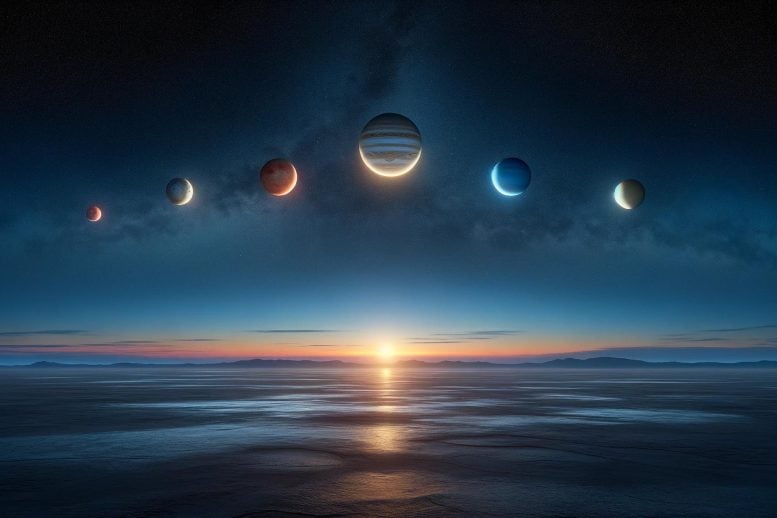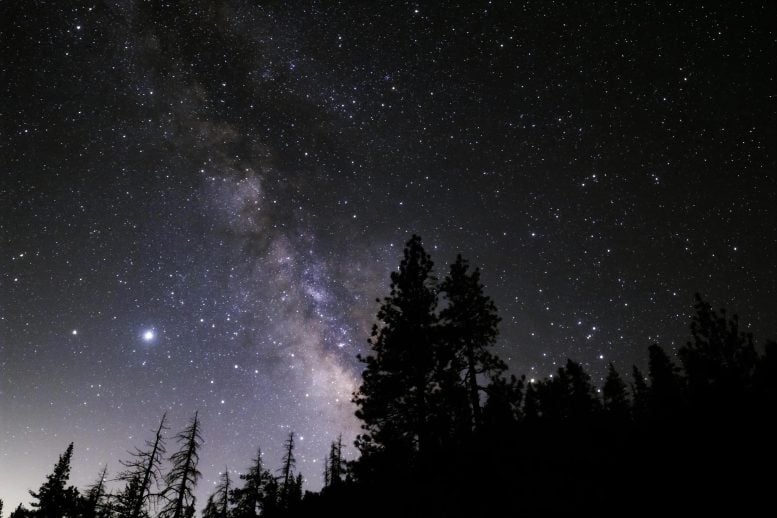
Stargazers can witness a rare alignment of six planets on June 3, best seen before sunrise from dark, high places. (Artist’s illustration of 6 planets in the sky.) Credit: SciTechDaily.com
On June 3, an alignment of six planets—Mercury, March, Jupiter, Saturn, UranusAND Neptune—will be visible just before sunrise from dark, high points with minimal light pollution. This rare event requires optical assistance to see all the planets.
Stargazers will have an incredible opportunity to look for six planets in Earth’s solar system on June 3. Mercury, Mars, Jupiter, Saturn, Uranus and Neptune will appear, from some dark, weatherless spot on Earth, to form a more-or-less straight line in the night sky – but it’s going to take some help optical to see it all.
The alignment is a bit of an illusion, astronomers are quick to point out, given the different elliptical path of each planet’s orbit around the Sun. But the unusual arrangement can be truly fascinating – if the local weather doesn’t interfere.
Best viewing times and locations
The planetary alignment is likely to be most visible 30-60 minutes before sunrise, looking east from a dark, high vantage point with minimal light pollution and an unobstructed view of the full horizon.
“If you were somewhere else in space other than Earth, these planets wouldn’t look aligned at all,” said Dr. Alphonse Sterling, astrophysicist at NASAMarshall Space Flight Center in Huntsville, Alabama. “It’s not unusual to see two or three lined up, but to have six of them lined up like that is unusual.”

Astronomers and stargazers around the world should be on the lookout before dawn on June 3 for a “planetary parade,” a loose alignment of six of our neighboring worlds: Mercury, Mars, Jupiter, Saturn, Neptune, and Uranus — though the latter two will require high-powered binoculars or a telescope to spot. Credit: NASA/Night Sky Network
Viewing planetary alignment tips
Mars and Saturn will be identifiable to the naked eye, and Mercury and Jupiter can also be seen near the horizon. Adding Neptune and Uranus to the lineup, however, will require the use of a high-powered telescope or binoculars.
“You can see it basically anywhere that doesn’t have a ton of light pollution,” Sterling said. “You just need a clear view looking east. Jupiter and Mercury will be the last to join, rising just above the horizon. You won’t see six bright dots lined up. Under the best of circumstances, you can see Jupiter, Mercury and Mars and Saturn. You’ll need binoculars or a telescope for others.”
Future possibilities and rare alignments
The alignment of six planets occurs rarely, depending on the orbit and position of each planet as seen from Earth. Indeed, we may see a second performance later this year. The same rough alignment of the six planets may be visible in the predawn hours of August 28 and again on January 18, 2025.
This is certainly more common than a full planetary alignment, in which all eight planets in our solar system appear to fall in rough formation on the same side of the Sun. Given all the factors involved, including the orbital plane, speed and distance of each planet, estimates suggest it would take more than 300 billion years for this to happen just once.
This is longer than the estimated lifetime of our parent star, so don’t wait.
Recent skywatching highlights
The planetary alignment is the latest sky-watching event in a recent period filled with them. Space enthusiasts enjoyed a total solar eclipse on April 8 and a rare sighting in May of the aurora borealis over parts of the continental United States — the result of an unusually large geomagnetic storm.



